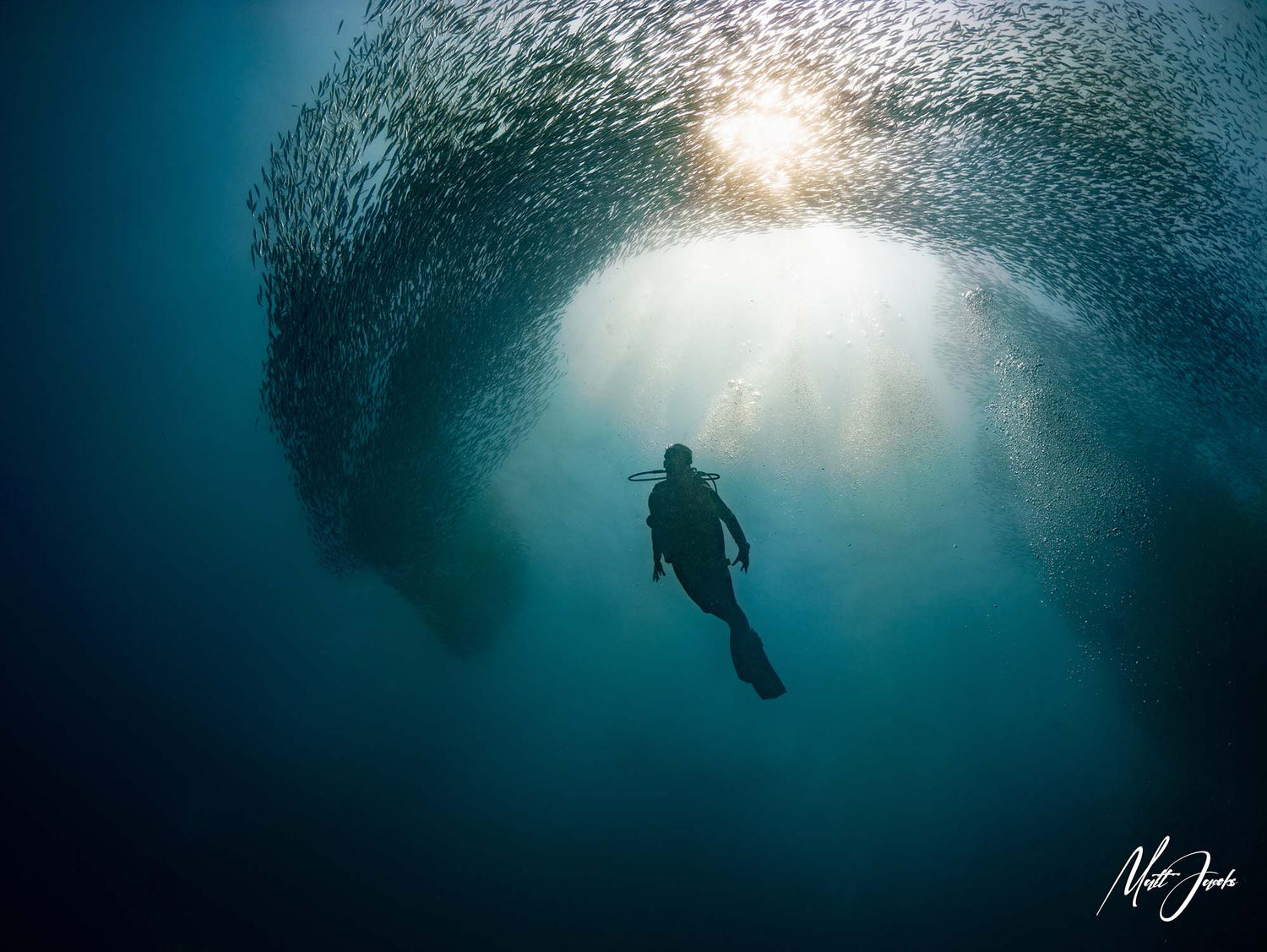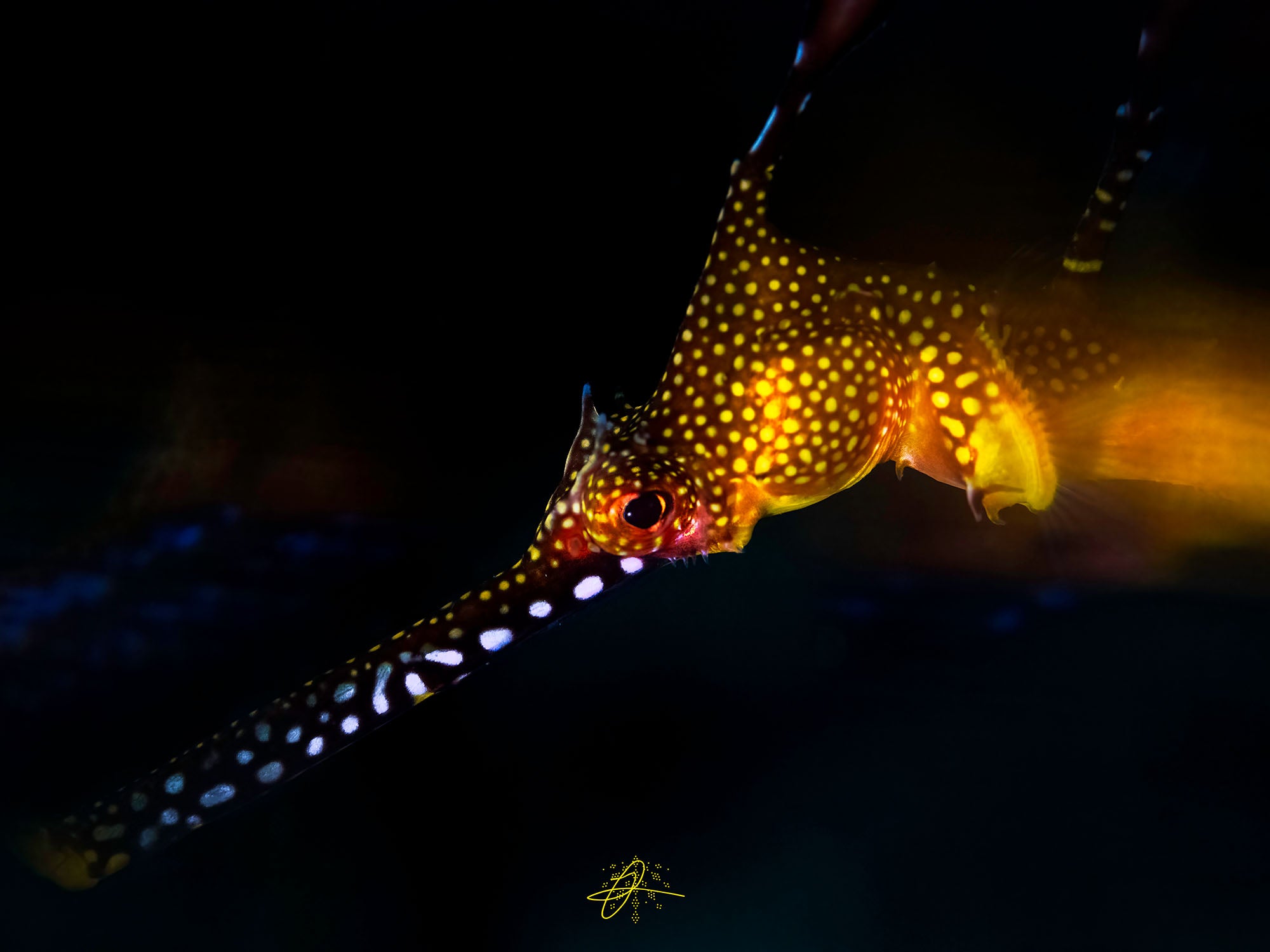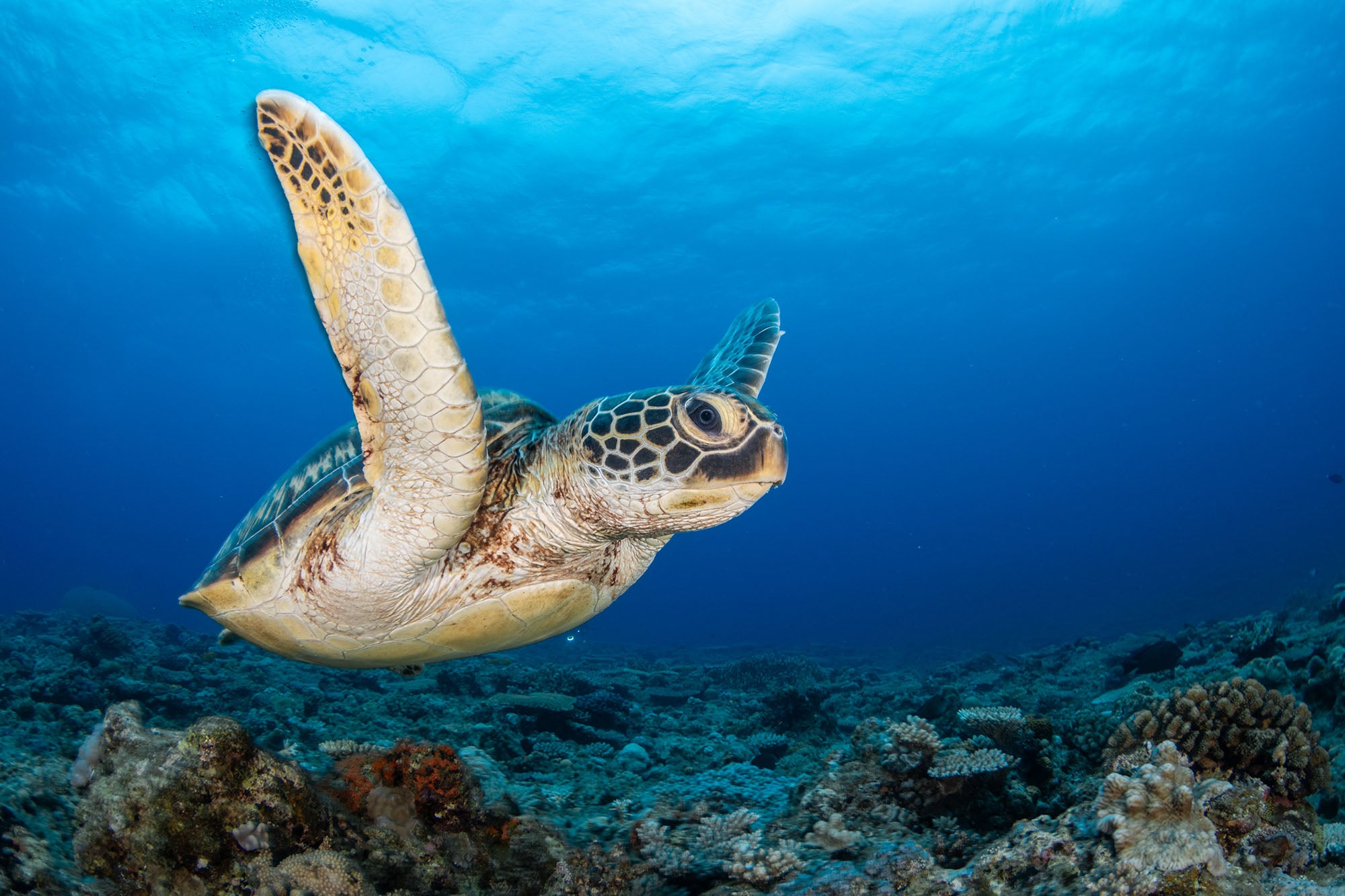By Ambassador Matt Jacobs
All images © 2024 Matt Jacobs
3am. Jet lag has me in its grip. My body is exhausted but my mind is racing. I open my apartment doors and look at the dead calm sea in-front of me with the light from the waxing moon highlighting its mirror-like stillness. I need to cool and the ocean is too inviting to turn down. The beach is well known for black tip reef shark pups so I grab my fins, mask and snorkel along with my dive torch.

Thresher sharks doe-like eyes give them their cartoonish and endearing look. © Matt Jacobs
The water soothes my body and I fin lazily out over the reef as it slowly drops away. The visibility is 30 metres and my torch light dances deep below me. In my peripheral vision something moves underneath me. Something big. A dolphin! Why didn’t I bring my camera? I catch another fleeting glimpse and notice it’s finning from side to side. This is no dolphin. It disappears and I search for it with my torch and it reappears again always on the edge of my vision. This is too big to be a reef shark. I’m comfortable with every kind of shark on SCUBA but I’m at the surface with a snorkel. Alone. At night. I feel vulnerable.
The shape appears again, but I can’t illuminate it. My mind starts to race, were those stripes on its back or am I imagining it? It's prime tiger season here. I swallow hard, and slowly, very slowly, start to fin for the shore. The fact I can’t see it anymore only serves to sends my imagination into hyperdrive. I make it back to the beach, breathing hard and lay down in the soft white sand looking up at the impossibly bright stars and start to laugh. My trip has begun. I’ve arrived.

The scythe-like tail of a thresher shark is used like a whip when hunting. © Matt Jacobs
Malapasqua
I’m in Malapasqua, the Philippines to shoot the thresher sharks. This is the only place on the planet where you can reliably see them and they’re virtually guaranteed on every dive.
I need to choose a dive centre and begin to enquire at several establishments. Most of them seem disinterested, lazily pointing at price lists. I get the feeling they’re catering to pre-paid package guests. I need somewhere with a vibe, somewhere with a soul. Exhausted, sweating profusely and rapidly losing hope of finding somewhere, I walk into the air conditioned haven of the Little Mermaid Dive Resort where I’m greeted by a concerned lady by the name of Santi.
I explain I need to shoot big stuff, sharks. Lots of sharks. “Never mind the sharks for now sir, please drink this," she hands me a glass of ice cold water and I feel myself coming back to life. I explain again what I need and Santi strangely seems to undersell what she can offer: “To be honest sir, you may only see a few threshers, not much else and the visibility at the moment is not so good." She pushes another glass of water towards me. I tell her I don’t want to see small stuff, “If anyone so-much as points out a nudibranch I will exit the water immediately.” Santi’s eyes narrow as she draws long and hard on her cigarette whilst fixing me with a stare. She realises I’m not joking. I leave the Little Mermaid and walk around twenty yards along the beach. I stop and smile. I like Santi, she has a good spirit and the dive centre is well stocked with brand new tanks. I walk back in and say I want to dive with them solidly for two weeks. I’ve found my tribe.

Readers booking with Little Mermaid through this article can receive free nitrox.
I find out later that Santi told Kevin the manager that she didn’t think I would be back. Heidi, a fellow diver at the centre, asks me later, "has it ever crossed your mind that she didn’t actually WANT you to come back?” “Never. I’m a constant delight…”
The next day I’m assigned my guide, EJ, a highly experienced and knowledgable Filipino who I immediately take to, he is patient and understands the shots I need to get. He briefs me on the Threshers. They used to be found at Monad shoal at around 30 metres down where divers would hang onto to a rope and hope to catch a glimpse of them in the early morning. Lucky for me they’ve moved to Kimud shoal, a beautiful, shallow reef between 12 to 18 metres deep with some stunningly beautiful hard coral. “Be patient and the Threshers will come up to be cleaned of parasites by the cleaner fish.”
I’m using my LUMIX GH6 with an Olympus 8mm 1.8 fish eye with an 8inch dome so I need to get close to these sharks, very close, or they will be a speck in the distance. With Santi’s words in my ears about low viz I’m not holding out much hope.

The gear: Lumix GH6 inside an Ikelite Underwater Housing with 8" Dome Port.
After a 40 minute boat ride to the reef, I giant stride into the water and someone hands me down my camera. I look down and am astonished to see 30 metre visibility. This is bad viz??
It’s just me and EJ and he leads me to a coral plateau drop off. He becomes motionless and hangs slightly out in the blue. We wait. Santi was right, I’m not going to see anything.
I look up and EJ is lazily pointing to his left as if pointing out something as common as a clown fish. I look to where he is pointing, my eyes widen, my heart starts racing, two huge thresher sharks are coming up over the drop off towards me.

© Matt Jacobs
These are magnificent creatures, with impossibly long tails and huge cartoon like eyes and with a permanently shocked expression on their faces. Their bodies look like polished aluminium that changes to a glittering bronze when the sunlight hits them.
I have a trick to get sharks close to me which has worked with Bulls, Tigers, Longimaunus and Grey Reef sharks. I’m hoping it will work with Threshers. I gently move my camera from side to side and the reflection in the dome draws the attention of sharks and they instantly turn towards me and move in to investigate. I start moving the camera gently in a rocking motion. YES! A Thresher comes in fast and close, very close. I hit the shutter and look at the screen. “Writing to card” It stays displaying the same message. I turn the camera off and on again and get the same message. NOOO! What a time for a card to fail on me.
Back on the boat I’m tempted to open the housing and change cards. I have the vacuum pump with me but I’m reluctant to do this on a boat where I have no cover and the wind is blowing. I elect to be patient and open it back it my apartment. But what if I never get that close to a shark again? On land I put in a blazingly fast CF Express card with a whopping 1tb capacity in place of the faulty SD card, switch the camera to burst mode and test fire it for full 5 seconds. No buffering at all. I’m ready.
We are in the water and EJ is hanging once again. Waiting. The Threshers duly appear and I start to shoot. And shoot. One feisty shark keeps coming in fast and close, some people remark later they have never seen the sharks get that close to a photographer before. This particular shark comes in and actually touches my camera with a pectoral fin as if high fiving me.

Thresher shark high-five © Matt Jacobs
I have my red filter on the back of my lens to neutralise the blue. I usually need to manually white balance the camera every few metres I change depth but here I’m at a constant 14 meters so I set it and forget it. Strobes are prohibited here due to the sensitivity of the Threshers eyes which are designed for the extreme depths and low light of 500 metres down (they’ve been tracked down to 1500 metres) where they usually hang. No strobes poses no problem for me as I never use them underwater. I’m well practiced at being aware of where my light is coming from. I shoot fully manual to give me as much control as possible and my metering mode is assigned to a custom button. If the sun is behind me and illumining a shark I choose centre weighted, if they come out of the sun I switch to spot metering to prevent the shark being in silhouette. Sometimes however I want them in silhouette.
Although mainly slow moving when they are being cleaned, Threshers are capable of astonishing bursts of speed, indeed they are one of the fastest sharks in the world reaching speeds of up to 30 mph. Even with my shutter speed at 1/400 sec I couldn’t freeze one large female as she twisted and turned with incredible speed in front of me.
Their tails provide immense propulsion and we often witness them breaching at the surface in attempts to smack the parasites from them as they land. Their tails are also used to stun schools of fish and such is the power in their tails that they do not actually have to hit the fish. The energy creates a shock wave in the water which stuns them.

© Matt Jacobs
I can’t get enough of photographing these miracles of evolution and I dive day after day doing 3 dives every day.
After a week, Kevin insists I need a break from the sharks and puts me on a boat to dive Gato Island. I feel like I’ve been put into rehab for shark addiction and reluctantly get on the boat.
The island has a spectacular underwater cave that runs from one side of the island to the other where sleeping white tip reef sharks can be found. I have a new guide for this dive who didn’t get the memo about me and small stuff. He points out a blue ringed octopus, the macro guys lose their minds and I can still hear their squeals of delight as I drift away looking for something big. We moor up in the beauty of the cave mouth and I skip the last dive to hang in the water and get some over/under shots.
Rehab completed, I’m reunited with my enabler EJ for more sharks. We dive Monad shoal each morning looking for tiger sharks. Monad is huge with a sandy bottom and the viz can blow out if the current picks up. EJ makes the sign for a tiger and I see her, she is huge, the biggest tiger I’ve ever seen, she’s waddling along like tigers do, she’s old, her stripes are fading. I swim towards her, I need to get her close to me but she lazily turns away with a distain for my attempts to capture her. We spot her a few times more on other dives but alas she won’t play ball and with my fish eye she is just too far away.

Heidi gets her shark photo © Matt Jacobs
The Threshers, however, are far more accommodating: posing, flexing, and actually touching my dome with their noses. Heidi asks if can get a photo of her with a Thresher. “Its tough,” I tell her. “I need to get a shark to come close, I need you in the shot and no other divers in the photo. Stick near to me and I’ll see what I can get."
The current is strong on this dive and the Threshers are on the edge of the drop off. I don’t want to suck a ton of air in the current so I hang on to the bottom of the shot line and stay there, just watching. EJ asks if I’m ok as I’m not moving. I stay there for 50 mins still watching.
Then I spot Miss Feisty (the Thresher from last week, not Heidi). I recognise her from her nose scars. I know I can attract her and she will play ball. I signal to Heidi to move to the drop off and she duly obeys and hangs there. I let go of the shot line and move my camera left and right, the shark comes in fast and close to investigate and Heidi is underneath her. I hit the shutter. Right, lets go up. I do 30 dives with the sharks at Malapasqua and I still want more, but I have appointment with the sardines in Moalboal.

© Matt Jacobs
Moalboal
Moalboal is a 20 min boat ride and a 6 hour car ride away. Heidi is to make the journey a few hours later and meet me there. She tells me to stuff my pockets with as much chocolate cake as I can carry from the breakfast buffet so she is not hungry when she gets there in the evening. I oblige.
Moalboal is world famous for its sardines. Massive schools of them hang out just yards from the shore making them easily accessible year round. It’s the huge bait balls we want and when Heidi arrives we find a dive centre and agree a price for a private guide to just take us two. I’ve never dived in huge schools of sardines before so I don’t know how to approach photographing this. I tell Heidi without her in the shots they are meaningless as there is no scale. We agree if she gets into a bait ball I will swim around it and we will try to meet in the middle. In the water, small schools of sardines are everywhere but our guide knows what we want and he signals us asking if we are ok to swim a distance to get to the big stuff. We set off.
The schools appear in the blue, massive, planet sized balls of swirling masses of fish all moving as one in a mesmeric display that leaves you in awe. Heidi approaches one towering school of fish and they dwarf her. The fish move to create the illusion of huge whale about to swallow her and in the next second they shape shift in what appears to be a massive skull. It leaves me wondering if this is by design like a mimic octopus, or mere chance.

The skull © Matt Jacobs
Heidi enters the school and disappears. I fin as hard as I can around the other side and enter. I swim towards where I thinks she is and the sardines part in a graceful arc and Heidi is revealed in the middle. I hit the shutter.
Being inside the ball of fish is other-worldly and disorienting as they swarm around making you feel miniscule. You have no perception of depth or direction. In the blink of an eye the school evaporates leaving you in the blue with no idea where the reef is. Our guide is well prepared for this and flashes his torch to orientate us to him and the reef.
I’m fascinated by the fact that no predators come in for the sardines. There are all sorts of sharks in these waters and dolphins are common yet none take advantage of this smorgasbord that is available to them. Somehow these sardines are protected and never move from this area.
After three dives were are sardined out and find the nearest bar to review the photos, not just of Moalbaol but the entire trip, topside and underwater. A wave of emotion cascades over me when it sinks in what a wonderful rollercoaster of a trip it has truly been.

© Matt Jacobs
Malaspasqua and Moalboal are unique in the world. No where else can you be almost guaranteed the experience of getting this close to sharks without baiting or feeding them. Nowhere else can you be assured of swimming with huge schools of sardines just yards from the shore.
Indeed the entire Philippines is a very special place being in the heart of the Coral Triangle and being one of the few sites in the world with the highest marine biodiversity importance. Just don’t show me the small stuff…
 Ambassador Matt Jacobs learned to dive in the Philippines while he was traveling around the world extensively as a photographer in the late 90's. It was only natural to combine his passion for photography with his love of the water. Egypt is now his spiritual home with a special fondness for the Red Sea. Matt is a Panasonic LUMIX Ambassador and his work has been published and sold as fine art internationally. Read more...
Ambassador Matt Jacobs learned to dive in the Philippines while he was traveling around the world extensively as a photographer in the late 90's. It was only natural to combine his passion for photography with his love of the water. Egypt is now his spiritual home with a special fondness for the Red Sea. Matt is a Panasonic LUMIX Ambassador and his work has been published and sold as fine art internationally. Read more...
Additional Reading
An Underwater Rockstar Among Royalty
Solutions to Photographing Schooling Fish
The Greatest Classroom on Earth: Teaching Underwater Photography in South Africa
Euphoria | Underwater with the Panasonic Lumix GH5 [VIDEO]
Under Pressure | The Art of Underwater Filming with Matt Jacobs [VIDEO]













